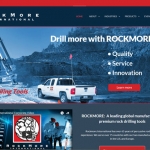Web Design Trends – Is Your Site Keeping Up?
Web design and creation is a constantly changing landscape. Breakthroughs in technology are constantly presenting new challenges and opportunities. Here are a few of the current trends that might affect the way you do business online.
1. Long-scrolling websites:
In the old days (a few years ago), conventional wisdom held that all critical website content had to be “above the fold,” in other words, it had to be visible on the screen without scrolling. It was thought that people would not be willing to scroll down on a web page to see content.
All that has changed, thanks to the increased use of mobile screens, and the rise of infinitely-scrolling sites like Facebook, Instagram and Twitter. These days, site visitors are accustomed to scrolling down a page to reveal more content.
This has led to many sites now having a long home page, with links to other site pages. And there are even sites that exist on a single long page.
Takeaway: Could your website benefit from having more scrollable content on the home page?
2. Experience design:
Once upon a time, web designers were mainly there to “pretty up” a website, to make it look good through their choice of fonts, graphics, colors, and so forth. Nowadays, it would be more accurate to call them “experience designers.” A good web designer designs the entire experience of the site visitor.
Good experience design still makes the site look beautiful, but it does much more than that. It designs the entire journey that the user will go through on the site. It’s a human-centered approach that eliminates friction and makes it easy to use the website.
Takeaway: Has your website been designed from the ground up to provide an easy, frictionless experience for the user?
3. Conversational user interfaces:
Being able to talk to your computer has been a science fiction dream – just think of Star Trek, or the HAL-9000 from 2001: A Space Odyssey. These days, that technology is one of the most exciting and rapidly advancing breakthroughs in the online world.
Most people these days are familiar with intelligent personal assistants (Siri, Alexa, Cortana, etc.) that use a natural language interface to search for information or perform tasks. But on a more basic level, many businesses are using chatbots – text-based automatic response programs that mimic human conversation. These chatbots are programmed to answer questions, provide information and even take orders. They are often integrated with messaging apps like Facebook Messenger or WhatsApp.
Conversational interfaces are going to be a bigger and bigger deal in the coming years. Already, more people are using messaging apps than are using social media, and 46% say they would rather contact a business through messaging than through e-mail.
Takeaway: Be aware of this trend and think about ways that your business might benefit from conversational interfaces with your customers.
4. Simpler navigation:
Simplifying navigation as much as possible will help create the optimum user experience. You want to limit the number of choices that the site visitor has to make, while making it as easy and intuitive as possible to find what they need.
As long, scrolling pages (see #1 above) can lead to difficulties in navigation, this has led to the rise of fixed or “sticky” navigation, where the main navigation bar “sticks” to the top of the screen as the user scrolls down. This keeps the navigation visible at all times.
If you have a lot of navigation categories, such as different products or services, work out how to organize them as sub-menu items under a main menu category. Companies with a lot of products or options have used mega-menus – a drop down interface that typically lists all product or service offerings , sometimes organized by categories.
Of course, just because something is “trendy” doesn’t mean it is a good thing. One modern trend is to attempt to hide or minimize navigation to make the site look “cleaner.” This includes hiding navigation under a hamburger menu (short horizontal lines usually used to indicate a menu on a mobile device). Studies have show this makes it harder for the user to navigate the site.
Takeaway: How can you simplify and improve your site navigation?
5. Content, content, content.
Many things change, but good, interesting website content will always be of prime importance.
What continues to change is the ways we create, promote, and share content. Have you thought about your content strategy? Should you have a blog? A video channel? Should you be doing webinars? Podcasts?
It’s important to consider why you are creating content. Who are you trying to reach? What information do you want them to have, and why? How will it forward your business goals?
And consider all of the channels you can share and promote content – should you be using Facebook? Linkedin? Instagram? Snapchat?
Takeaway: How could you create and share more online content to advance your business?
What trends have you noticed that influence how you do business?








